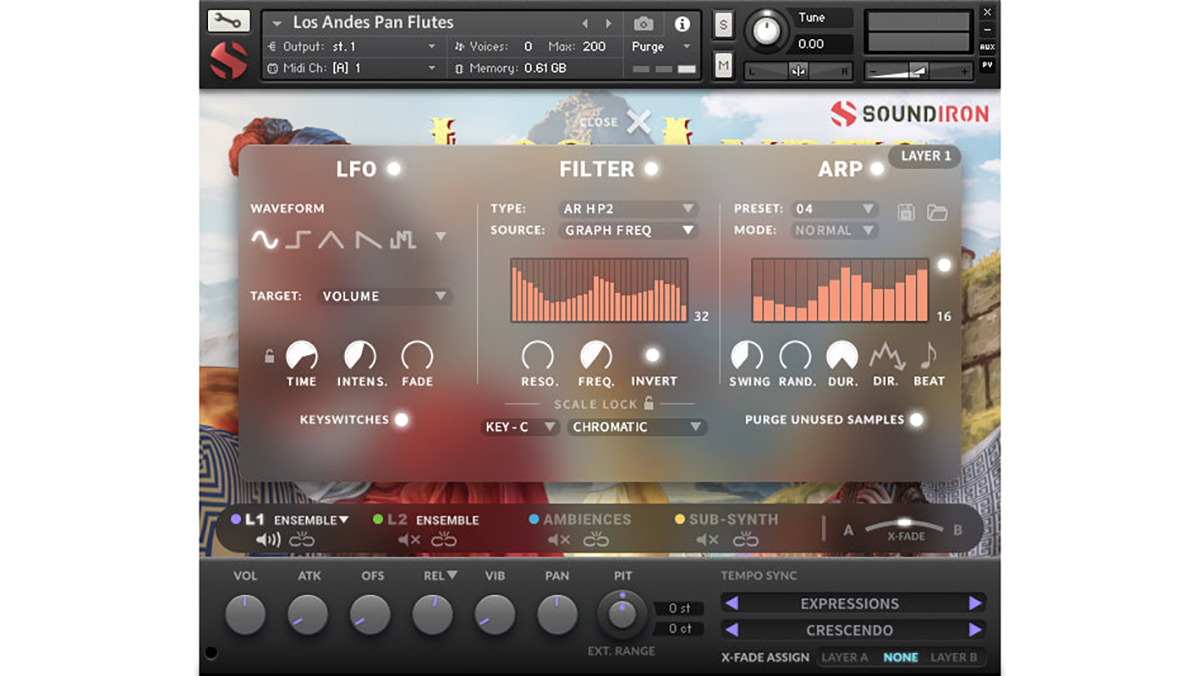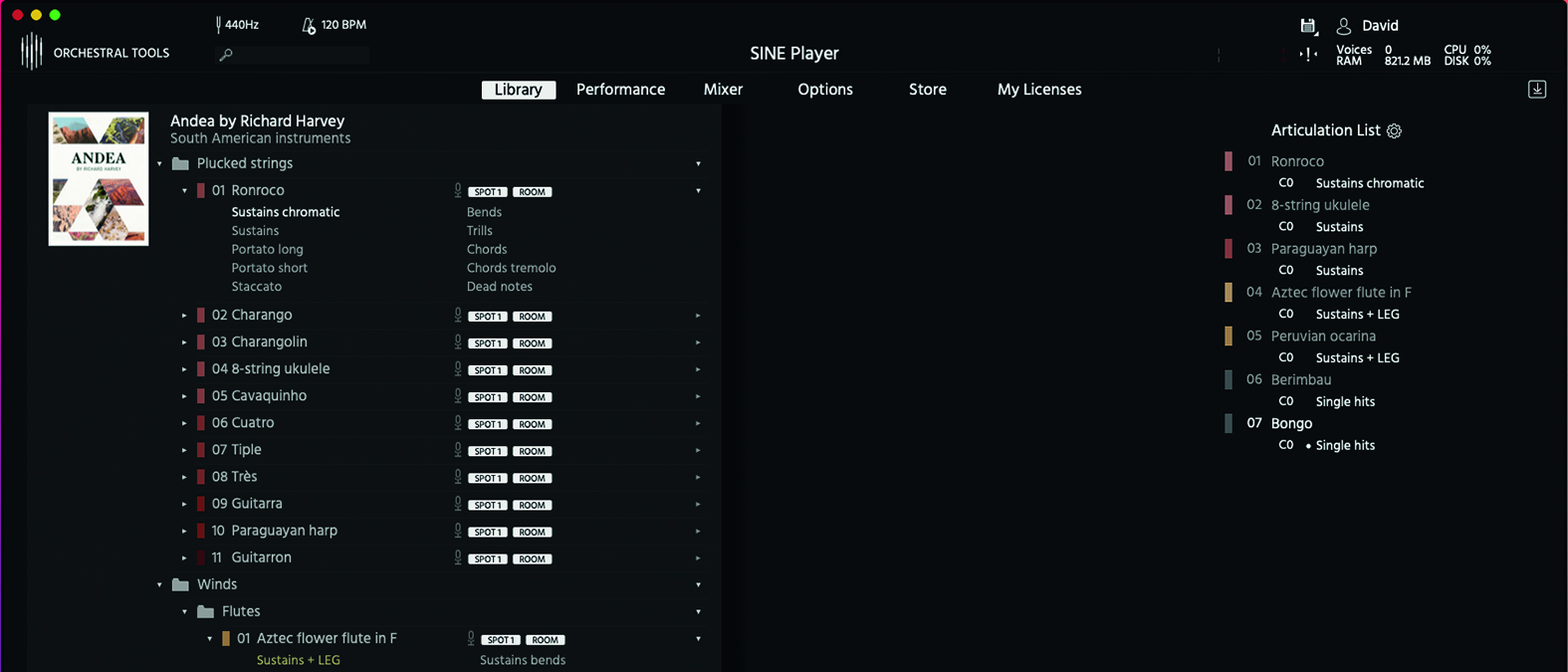MusicRadar Verdict
A finely crafted collection of instruments, presented in a concise manner. They’re as rich as they are abundant and full of optimism for the creative process.
Pros
- +
A beautifully crafted set.
- +
61 included instruments.
- +
Comprehensive list of articulations.
- +
Simple but effective miked elements.
- +
The content provides enormous variety.
Cons
- -
No phrases, grooves or loops.
- -
Some latency present.
MusicRadar's got your back
Orchestral Tools Andea: What is it?
In our experience, sample libraries with an emphasis on ethnic and world sounds tend to fall into two camps; they either provide a smattering of generic sounds, which are ideal for flying into general production work, or they are heavily focused on regions of the world.
With the latter in mind, extensive sampling of both instrumentation and articulation normally follows, coupled with multiple microphone placements, and that’s what we have here.
Orchestral Tools’ newest suite heads for the Americas, concentrating on southern and central regions. With such a large geographical expanse, OT has sensibly brought multi-instrumentalist, composer and musicologist Richard Harvey aboard.
Richard has been studying many of these wonderful instruments for around 40 years, as well as building a sizeable collection of instruments from the region. As a successful film and media composer in his own right, he is well placed to understand the preferences of producers and composers, when charged with finding the right library to cater to a producer’s needs.
Sampling sessions were carried out at SML studio Surrey by Richard, with two additional instrumental specialists; Mauricio Venegas-Astorga and Carlos Fuentes. Despite their involvement, this is not a phrase library, it’s very much a multi-sampled library, designed to be played from the keyboard.
There’s a vast collection of instrumental timbre available, while the library is designed to run within OT’s own Sine player, existing as a standalone platform, or plugin across the usual formats.
Orchestral Tools Andea: Performance and verdict
Upon installation and loading of the suite, you immediately notice that the instrumentation is beautifully categorised. Broadly speaking, this falls into three camps; plucked strings, winds and percussion. To an extent, this oversimplifies the complexity of the library, as within each section, the spectrum is broad.
We’ll begin with plucked strings. One of the main issues with working with world music libraries, is that you may not be entirely sure about the instrument you are choosing. Because this first section is entitled plucked strings, you do get a clue from the outset, but you may have to do a little referring to the OT website, to get the full picture. There are familiar names in the list, such as Charango and Ukulele, although the Uke available here is of the eight-string variety, with a suitably thick tonal construct.

• Soundiron Los Andes Pan Flutes
A broad, varied collection of panpipes, installed across 13 Kontakt instruments.
• Spitfire Audio Charango
This freebie offers the essentials. It’s basic, but appealing.
The first instrument in line is a Ronroco; this is a 10-string mandolin-like instrument, that provides a relatively deep tone. The articulation list, within each instrument’s section, does alter from one to the next, but in all instances, it is pretty comprehensive.
The Ronroco is a case in point, providing 10 different articulations, beginning with the obligatory sustains and short notes, before moving to bends, trills and chords, the latter being available as single strikes or really beautifully played tremolos.
Through the use of the Sine player, the mixer page provides a basic fader for both spot miking and room ambience. The latter is not overbearing at all, providing a neutral backdrop to prop up the closer miked signal.
Within the plucked instrument section, some instruments appear to suffer from a small degree of latency, when triggered from the keyboard. This is not so much a technical issue, as a challenge associated with some of the instruments themselves, and the articulations employed.
Of course, it’d be easy to rectify this in a DAW setting, but it will keep you on your toes, while encouraging you to listen to how these instruments might be placed in your track.
Winds and percussion
If we thought that the plucked string section was comprehensive, it’s nothing compared to the Wind section. Filled to the brim with 11 different types of flute, four panpipes and six ocarinas.
There’s a large amount of variety. All of these instruments have their own peculiarities, with some of them having a degree of split range, with notes missing in the middle.
If nothing else, it’s authentic, as is the employment of the legato articulation, which can sound sublimely effective. There is a nice level of timbral dynamics available too, as increases in dynamic range often result in an instrument subtly altering timbrally, as well as in volume
We were delighted to see the unique Berimbau represented, and recorded so beautifully at that
The percussion section also offers great authenticity, although in contrast to the previous sections, the timing feels exacting to the point of transient, and with many flavours of articulation included within a patch.
Take a familiar instrument such as the congas; samples are zoned into three different areas to allow for low, middle and high conga hits. There’s also a considerable variety of articulation, set out across the keyboard, alongside a substantial set of round-robin samples.
Through the Sine software, the ‘RR’ display immediately reveals how many round-robins are in play, allowing you to comfortably work without ever sounding machine-like. We were also delighted to see the unique berimbau represented in this library, and recorded so beautifully, with sonority and brightness in equal measure.
Coming to South-America
If we had to label this library with a single word, it would be ‘authentic’; it’s beautifully curated, with a vastness of instrumentation that covers all the significant bases from this region. It’s this conciseness that makes it so appealing to work with.
The sonic preparation is simple but beautiful. It is, however, a library of individual strikes and hits, with no elements that could be considered phrase-like, so you’ll need to experiment to keep authenticity stakes high.
MusicRadar verdict: A finely crafted collection of instruments, presented in a concise manner. They’re as rich as they are abundant and full of optimism for the creative process.
Orchestral Tools Andea: The web says
"An exceptional toolbox for any composer or musician looking to add some ethnic flair to their productions."
Sample Sound Review
Orchestral Tools Andea: Hands-on demos
Orchestral Tools
Orchestral Tools Andea: Specifications
- Works with Orchestral Tools’ SINE Player—NOTE: Very latest version required!
- SINEarc compressed: 24 GB / uncompressed 71 GB
- 24-bit / 48KHz patches
- System requirements SINE: Mac OS 10.13, i5, 4 GB RAM (16+ GB recommended). Windows 10, Intel Core i5 or similar.
- Interfaces: VST, AU, AAX
- CONTACT: Orchestral Tools
Computer Music magazine is the world’s best selling publication dedicated solely to making great music with your Mac or PC computer. Each issue it brings its lucky readers the best in cutting-edge tutorials, need-to-know, expert software reviews and even all the tools you actually need to make great music today, courtesy of our legendary CM Plugin Suite.
“Built from the same sacred stash of NOS silicon transistors and germanium diodes, giving it the soul – and snarl – of the original”: An octave-fuzz cult classic returns as Jam Pedals resurrects the Octaurus
What’s the buzz? Meet Yellowjacket, Cherry Audio's recreation of EDP’s trend-setting Wasp from 1978
“A fabulous trip through all eight songs by 24 wonderful artists and remixers... way beyond anything I could have hoped for”: Robert Smith announces new Cure remix album











